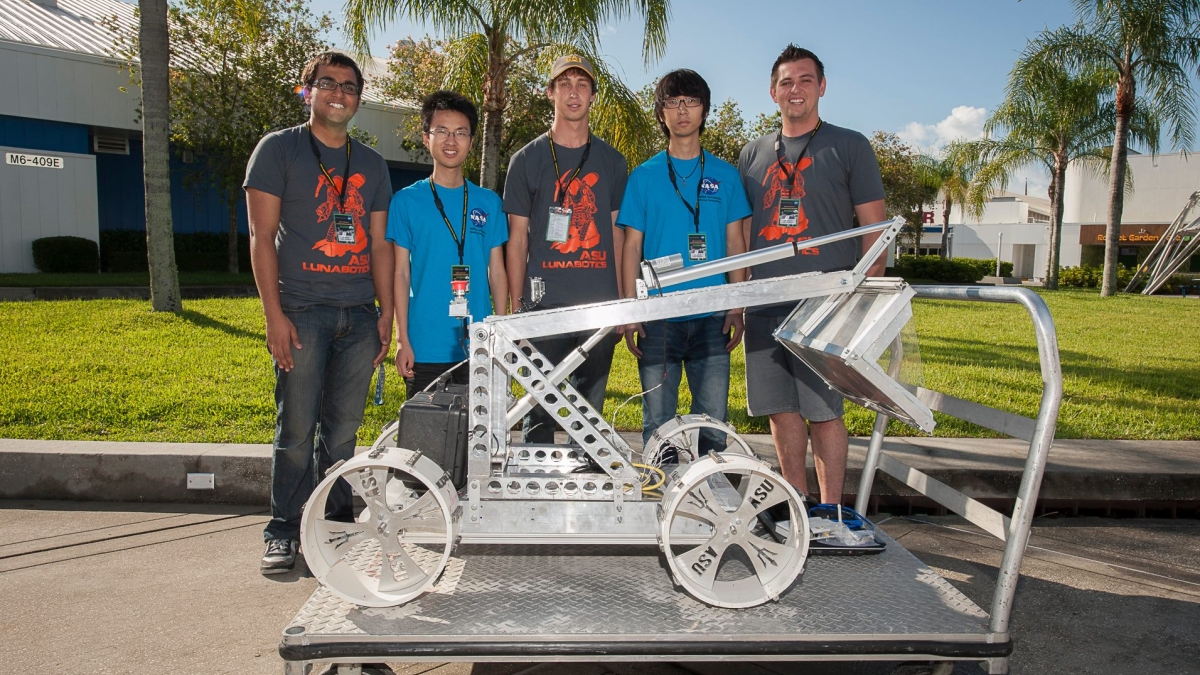ASU Lunabotics team competes at Kennedy Space Center

For the second year in a row, Arizona State University tested its Moon-mining robot design at the NASA Lunabotics Mining Competition. The event was held at the Kennedy Space Center Visitor Complex in Florida, May 20-24.
The international competition challenged university teams to design and build a remote controlled or autonomous excavation robot called a lunabot. The teams’ robots went head-to-head to determine which could mine and deposit the most simulated lunar soil within 10 minutes. Teams were judged on their robot’s dimensions and mass, regolith collection, dust mitigation, bandwidth and power usage, and the ability to control the lunabot from a remote control center.
Over 50 teams from around the world showed up for the weeklong competition. Australia, Bangladesh, Canada, Colombia, India, Mexico, Poland and the US were all represented at the competition. Iowa State won the overall grand prize, the Joe Kosmo Award for Excellence, for earning the most cumulative overall points. The ASU team placed 14th overall, collecting and depositing 15.7 kilograms of regolith on its second run.
“ASU Lunabotics spent the last year designing and building a completely new system,” says Ben Stinnett, leader of the ASU Lunabotics team and a ASU/NASA Space Grant intern. “Similar to a Caterpillar frontloader, this robot has a front scooping bucket that is actuated to collect the regolith.”
Stinnett was one of five ASU students to travel to Florida for the competition. He was joined by David Nelson, Aman Sharma, Jasper Jiang and Zhiqian Li. Stinnett is majoring in Earth and Space Exploration with a concentration in Exploration Systems Design. Nelson and Sharma both major in Aerospace Engineering, while Jiang’s major is Electrical Engineering and Li’s is Computer Science. The team roster also includes: Mason Denny (Earth and Space Exploration) and Jesse Banks (Earth and Space Exploration). Professor Srikanth Saripalli served as faculty advisor and he is also a ASU/NASA Space Grant mentor.
The team’s lunabot weighed in at 47.2 kilograms and measured 1.48 meters long, 0.5 meters wide and 0.6 meters tall.
The team’s efforts are the latest in a rapidly growing program in robotics and engineering in ASU’s School of Earth and Space Exploration, which combines science and engineering to produce the next generation of explorers.
The overlying challenge this year was communication. Many teams suffered from packet loss and dropped communications. The ASU team had this issue intermittently during its second competition run, causing them to lose a lot of time and only be able to make one run.
“Our first attempt was just human error. We didn’t properly secure the power wire for our router and ended up getting it caught up in our wheel. This pulled our router off the robot and we ran over it,” said Stinnett. “Overall it was a huge improvement from last year. We were one of a small number of teams who were actually able to collect something. We have a solid platform that we will continue to improve over the next year in preparation for the next competition.”
ASU’s Lunabotics team is sponsored by the School of Earth and Space Exploration, and the Autonomous System Technologies Research & Integration Laboratory.
For information about the competition, visit: http://www.nasa.gov/lunabotics